

Remembering the "other" Dick Venables and the "other" James Warren

Anyone who knows anything about drag racing — and especially readers of this column — knows the names of Dickie Venables and James Warren. Venables is well known as a three-time (and counting) Funny Car world championship crew chief with Matt Hagan, and Warren was a Southern California Top Fuel hero in the 1960s and ‘70s.
But today I’m going to acquaint you with the Dick Venables and James Warren that maybe you didn’t know, and neither of those two are the guys mentioned above, and sadly, we lost both of “the other” Dick Venables and “the other” James Warren, both in their early 80s, in the last week of December.
Dick Venables Sr., was, of course, the father of the talented crew chief we all know from today’s NHRA Camping World Drag Racing Series action as the tuner of Hagan’s Dodge-bodied Funny Car, and it was Dick Sr. who not only gave his son the mechanical start that had led to an amazing career in the sport but also launched the career of another Hall of Fame tuner, Rahn Tobler.
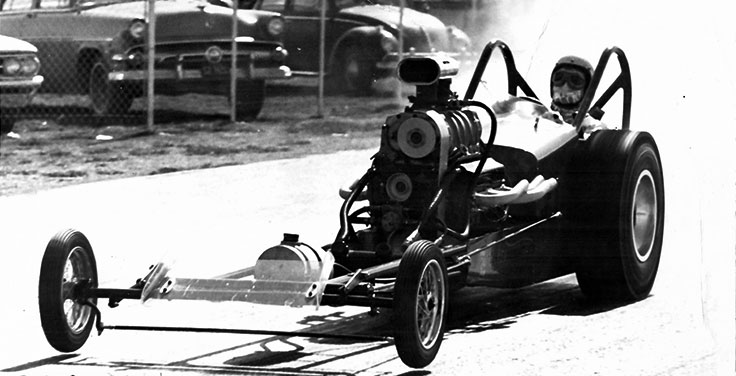
The senior Venables enjoyed a long racing career that began in the 1950s with a blown Olds-powered fuel dragster that he ran with partner Buggs Threadgill and had his own Top Fuel dragster in the 1960s before hooking up with fellow Houstonian Steve Stephens for a partnership that lasted a decade, from the early 1970s through the early 1980s.
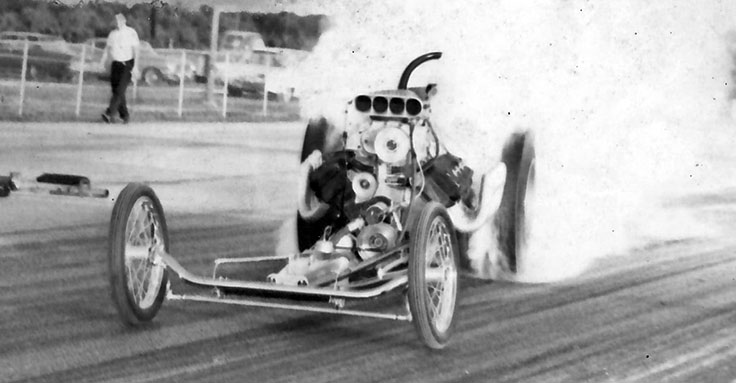
Venables owned an auto repair shop in Houston, and Stephens sold ads for the Yellow Pages, and they met at the drags. Before long, they’d decided to build a front-engined car together and went racing with Stephens driving and Venables tuning and the car based out of Venables’ business. Dickie Jr. was 7 when the partnership started.
“My mom would drop me off at my dad’s shop after school, and I’d help out washing parts or sweeping the shop,” Dickie remembered. “I didn’t get to go to the races a lot in those early years, but eventually, I went as often as I could, and I loved it.”
About that same time, Tobler arrived on the scene, a 17-year-old Southern California transplant who ended up in Houston after his mother’s job with Shell got transferred to Texas.
“I was working at a grocery store down the street from their shop, bagging groceries, and when I would drive [by] the shop it had a double door and then a single door, and the single door was always open,” recalled Tobler. “And inside of the single door, there was a front-engine dragster you could see from the street, and that piqued my interest. I grew up in Southern California and used to go to Lions [Dragstrip] with my buddies and was a drag race fan. One day, I walked up and just kind of leaned on the corner of the door frame. I did that on and off for probably two weeks and then one day they asked me if I wanted to come in and look at the car, and I snapped some pictures of this front-engine car, which I thought was the coolest thing ever.”
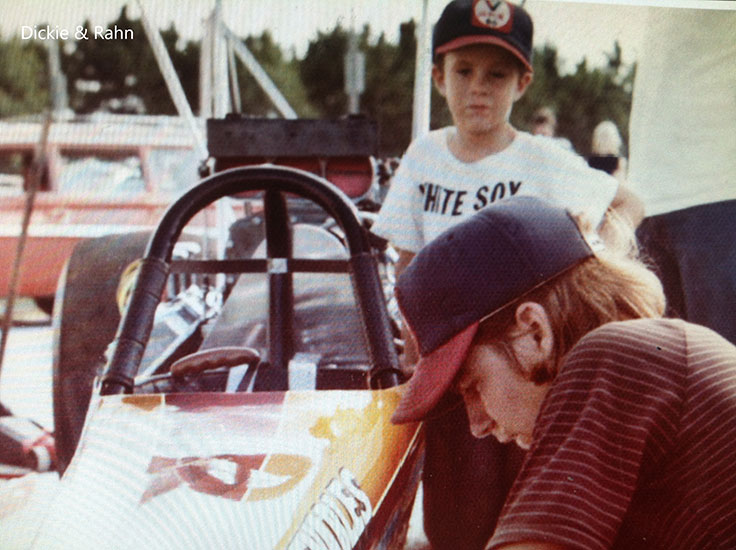
Before long, Tobler and the younger Venables were working together in the shop, neither realizing that they both would go on to have long and decorated careers in the sport and even become teammates at Don Schumacher Racing for more than a decade some 40 years later.
Because he was older (by about nine years), Tobler got more responsibility on the race car, learning how to build short blocks and such, and took his first road trip with the duo to the 1971 NHRA World Finals in Amarillo, Texas.
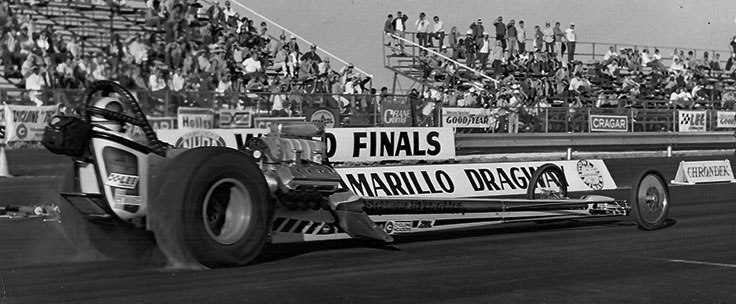
“I was 17 years old right, and so they had to meet my mother and assure her that they were going to take care of me,” he said. “It was just the three of us – me, Dickie, and Steve – in a Ford pickup truck with a single bench seat. Of course, they had been all, ‘Mrs. Tobler, we will take care of Rahn and watch out for him,’ and all those things? Well, halfway to Amarillo, the truck runs out of gas. Well, guess who they put on the road with a five-gallon gas can to hitchhike down the road and find some gas?”

(Steve Reyes photo)
In the middle of 1972, the team got its first rear-engined dragster and the team hit the road.
Remembers Dickie, “I was limited because of school, but I know I skipped school to go to U.S. Nationals and the Springnationals in Columbus, Ohio, a time or two. I went whenever I could, you know.
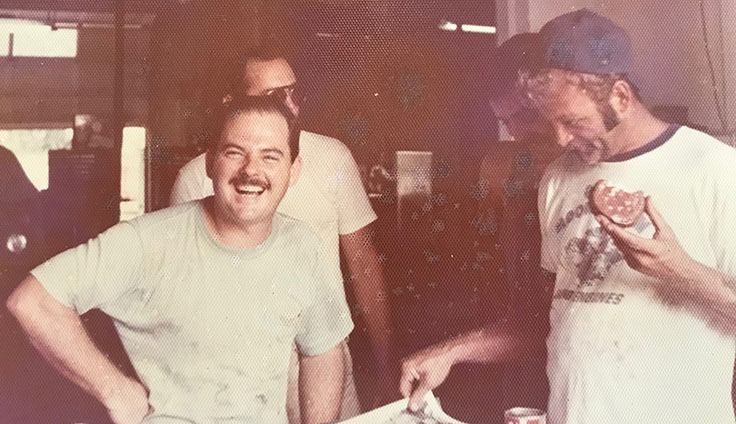
“I was hands-on and didn't really understand the tuning part of it, but my dad was the one who taught me how to be a mechanic, to make sure your tools are clean and organized, to make sure you have a system on how you work on stuff, things that I still preach to the guys who work for me now.”
The experience was much more intense for Tobler, who actually impressed his bosses enough that when he was 21 they offered to let him license in their QuickSilver dragster to further increase his experience.
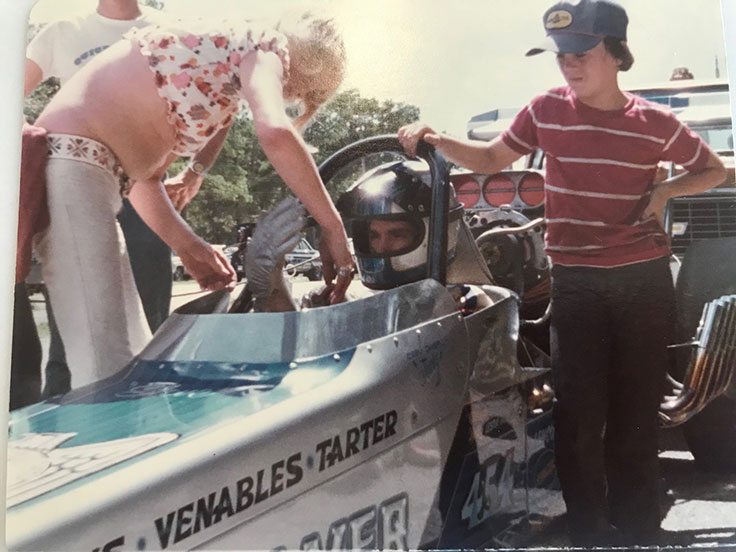
Rahn Tobler saddles up, with young Dickie by his side
“I'd never staged a car on a dragstrip in my life, and this is the push-start days,” he said. “We’d push down, then have to jockey back and forth 15 times to get it pointed down. I’d never been in any kind of car on a dragstrip, and they let me jump in this Top Fueler. I went 6.48 at 219 mph and got a AA/Fuel dragster license signed by [late Division 4 Director] Dale Ham. Those were great times. We all had jobs during the week and met every evening to work at the shop, from six until midnight or whenever the Budweiser ran out. And you know, and then on the weekends we go to the racetrack.
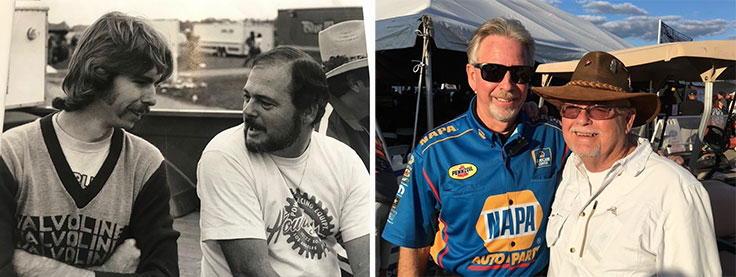
“I was a young man that never had a father,” Tobler continued. “I didn't know my father and was raised by a single mother, and from the age of about 17 to about 22 or 23, Dick and Steve were this positive male influence that really helped set me up for the rest of my life. So not only did they give me a start in the sport, but they also gave me a start in life. I almost think of Dick as a father figure. The start that he gave me shaped my entire life and my 50-year career in racing. I wouldn't be sitting here, married to my wife right now, if it wasn't for Dick Venables Sr. I wouldn't have done the things that I've done in life. He greatly influenced my life, not only the people but the sport and the career that followed.”
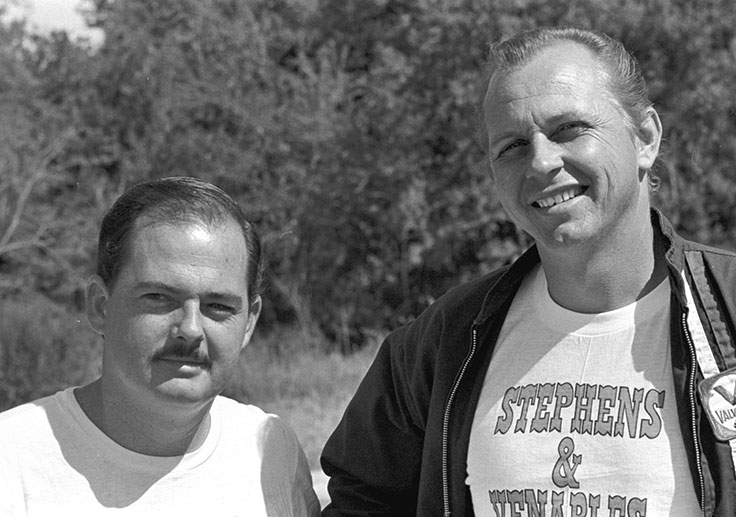
Dick Venables Sr., left, and Steve Stephens (Steve Reyes photo)
The Stephens & Venables team won a pair of Division 4 Top Fuel championships and expanded their operation in the mid-1970s to also include a Monza Funny Car — also named QuickSilver — after Sid Tarter joined the team with extra funding, but Tobler eventually went to work for Marvin Graham’s Top Fueler and then, of course, became a longtime and vitally important part of the life and career of Shirley Muldowney, yet remained tethered to the Venables family.
“We would come through Houston with Shirley's car — just me and her son, John — and we would stay with the Venables family for a couple of weeks so Shirley could run some Division 4 events or match races, so Dickie and I never really got that far apart. But then when Dickie graduated from high school in 1983, we picked him up, and that was his full-time job after that until Shirley’s accident happened [July 1984] then came back to work for us from 1988 through 1990.”
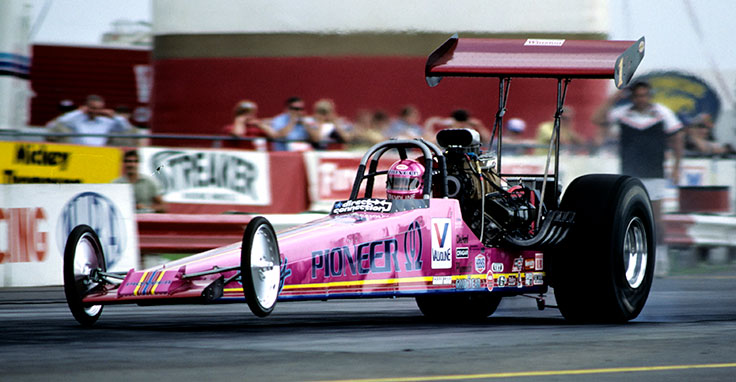
“Shirley was my first real race car deal,” Dickie expanded, “you know, as far as actually getting paid. We obviously did not on my dad's deal. I actually went with Shirley and Tobler in between my junior and senior year in high school and had to come back to finish my senior year. Then right after I finished high school, Rahn just said, ‘Hey, what do you think about doing this full time?’ I was 18, so I'm like, ‘Heck, yeah.’ Of course, my dad thought it was great. My mom didn't think it was too cool.
“It was unreal. It was a dream. I thought, ‘Wow, you're gonna pay me to do this?’ So I was just happy to do that, and it ended up turning out to be a career.”
And what a career for both of them. Tobler tells me that he has 70 career NHRA wins and estimates Venables has between 50 and 60, for a total of at least 120, which is pretty amazing considering there’s only been 1,000 events, that’s a 12% win ratio, and the duo have eight championships between them. And those records do not include IHRA or AHRA wins, of which Shirley had several. That’s one heckuva legacy for Dick Venables Sr. to leave.
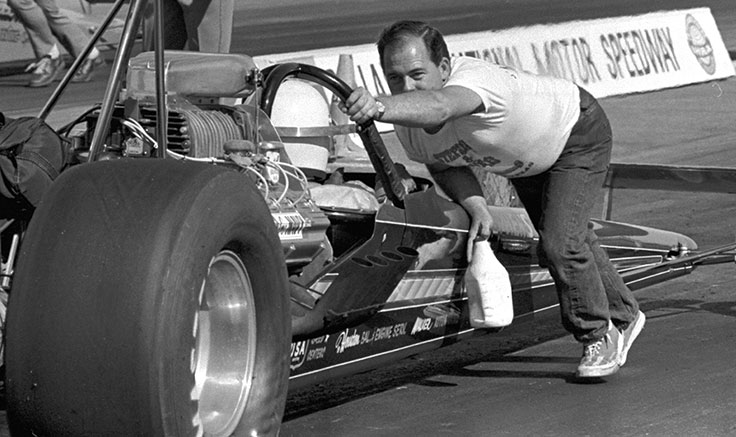
(Steve Reyes photo)
Venables died Dec. 29 at age 82 and lived long enough to see all of the success, some of it firsthand.
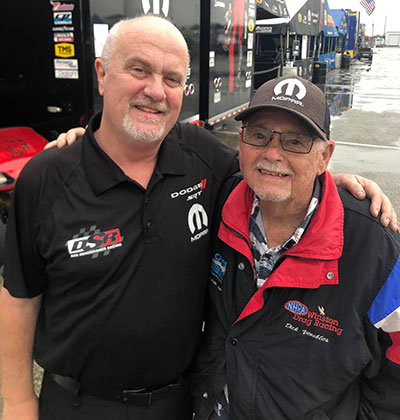
“He always would come to the races,” said Dickie. “Anytime we were in Houston or Dallas, and he always came to Indy, even up through this past year. And, honestly, I think him following it, following me and Tobler, kept him going in his later years. I really believe that.
“I didn't really realize how many friends he had until the past week, and honestly, I knew he was always proud of what I did. But as I talked to people since he's passed, they've made me realize how proud he was. So that makes me feel really good, and just knowing that he had a good life right up to the end gives me comfort. You know, he always told me that he'd done everything he wanted to do, so that gives me some peace, too, but we’re all going to miss him.”
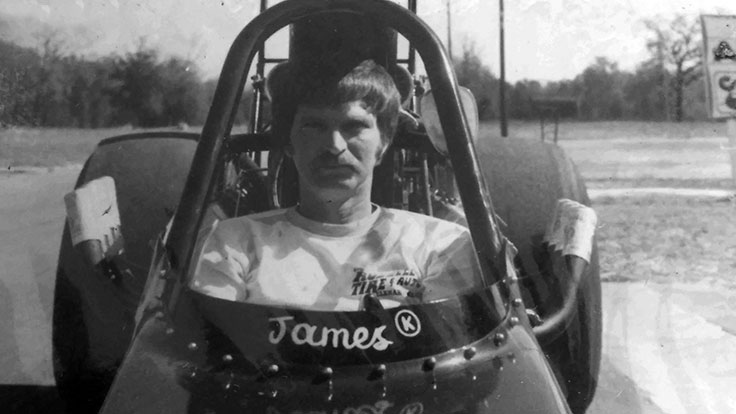
The James Warren that most of you know well — a multiple-time March Meet winner, Division 7 Top Fuel champ, and national event winner with the bright-orange Warren & Coburn dragster out of Bakersfield, Calif. — died in May 2011. Oddly enough, there was another James Warren who also raced Top Fuel, but a country apart, plying his trade in the Division 2 area from his Florida base.
James Keith Warren, of Oviedo, Fla., passed away Dec. 24, at age 81. As good as my knowledge of the sport is, I had never heard of him until his stepson, Alan Ridenoure, reached out to me.
Warren, a Navy veteran, competed in Top Fuel in NHRA and IHRA in the 1960s, ‘70s, and ‘80s and in the last decade had kept alive his need for speed with a Pro Dragster at tracks throughout Florida.
According to Ridenoure, his stepfather owned the unique honor of having the last front-engined Top Fueler to qualify at a national event staged by a major sanctioning body. More on that in a bit.
Warren was originally from Binghamton, N.Y., but moved south to Ocala, Fla., in the mid-1970s, which is where he met Ridenoure’s mom when Ridenoure was just 6. Before long, Warren had a 6-year-old crewmember for his car.

“He was living with his race car partner at the time, George Mikulyuk moved in next door to us,” Ridenoure told me. “He and my mom really hit it off. About six months later, he says, ‘Hey, you want to go to the races?’ I had never been to a race between Don Garlits and Shirley Muldowney at Bradenton [Raceway in Florida], and I was hooked. Back then, which was probably about 1977, you could walk right up to the fence, which was probably 15 feet from the guardrail.”
“He is the reason that I ever went drag racing. We were low-buck racers before anyone knew what low-buck was, but those are some of the best times I remember from my childhood. Many races we were pitted next to Paul Longenecker, Marvin Schwartz, Don Garlits, even John Force, Kenny Bernstein, and Al Segrini!”
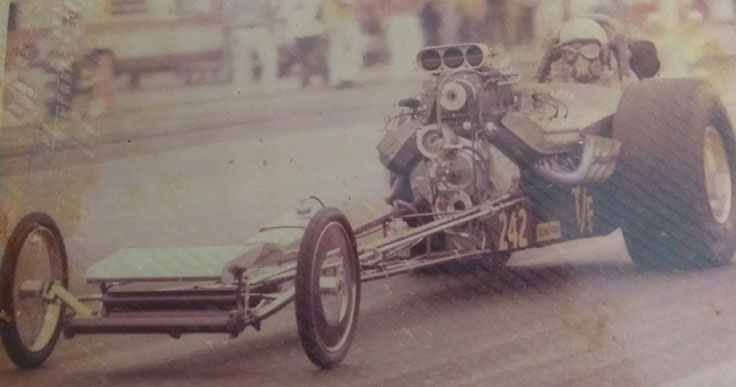
NHRA historian nonpareil Bob Frey confirmed the front-engined stat, finding that Warren qualified at the 1974 IHRA event at Rockingham Dragway, where he also won a round. Remember, this is more than three years after Garlits proved rear-engined dragsters could be successful and two years after the last front-engined dragster winner in NHRA Top Fuel history. According to Frey, Florida’s James Warren never could crack the field at an NHRA national event but did finish fourth in the Division 2 standings in 1974.
“We were pretty low buck, and we didn't have a lot of parts,” Ridenoure acknowledged. “In the '70s, it was a little easier, but the ‘80s is when we started to notice that if you if weren’t Kenny Bernstein with Budweiser or whatever you run in Top Fuel, it was a tough road. We tried it, but we just realized that it wasn't something that he was going to be able to do anymore. We just knew that. So we sold the car after the Bristol IHRA event in 1981.
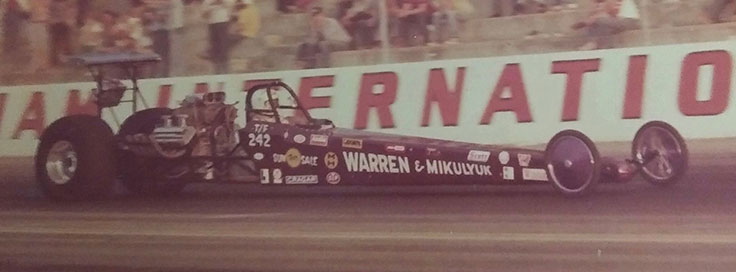
“It was cool just to be part of a Top Fuel team. Early on, I didn't know what qualifying really was or anything like that; I was having a good time. I thought I was something cool because I always kept a rag in my back pocket like everybody. I would walk around the pits with my mom, and all of the racers back then were really cool. Jim and Alison Lee were good friends of ours, and Paul Longenecker and Marvin Schwartz. I would take my rag and wipe their car off. I’ll never forget the time that Don Durbin threw me a dime and said, ‘Go buy yourself a race car. It was the greatest thing in the world.' I used to play with Jeb Allen’s son.”
“It was just a neat experience growing up, you know, obviously not knowing the difference between high-buck and low-buck racers. I remember meeting John Force probably back in 1980 or so when he was low buck, and I just kind of thought, you know, everybody did that. I thought growing up that everybody had a crankshaft standing up in their living room.”
“I probably thought I had the coolest dad on the block, and in later years, I really did when we wound up rebuilding a ‘47 Chevy with a 351 with a blower on it, and it was all under the hood. And now I'm thinking to myself, ‘I've got the coolest dad in the world.’ He was a good one. He was definitely a throwback.”
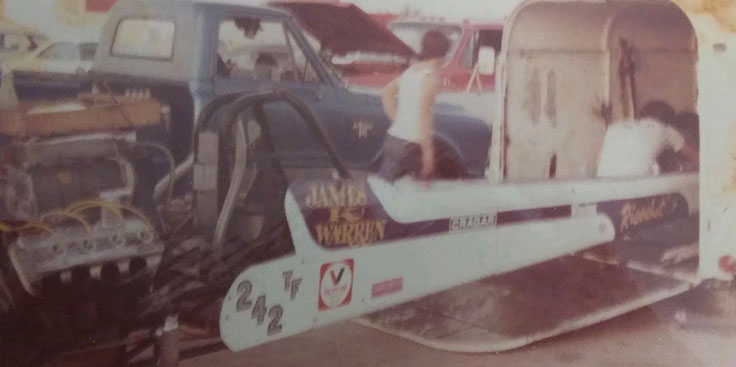
Warren’s car was crewed over the years by himself, Mikulyuk, John Robbins, Buddy Kellett, and even recent Insider column subject Bob Taaffe, who Ridenoure remembers committed the sacrilege of painting the dragster British Racing Green.
“At one point James had the longest car on the circuit, a whopping 280 inches,” he recalled. “The Ricochet dragster was a long car for its time, but those guys back in the ‘70s, they learned how to really engineer their own stuff. A lot of what Garlits did, [James] was trying to do some stuff; he even ran a three-speed at one point, so it was interesting.
“He and Garlits were pretty good friends because they both came out of Florida in the ‘60s and ‘70s and would race on the circuit with each other, whether it was AHRA, IHRA, or NHRA. I know they stayed in contact with each other throughout the years.”
And what of “the other” James Warren, the famous one from California. Did he know about his cross-country counterpart?
They raced at least one event together, the 1977 Gatornationals. According to Mikulyuk, Warren from Florida was paired up with James Warren from California in a qualifying run. He said the announcer made a big thing out of “Well, we know James Warren is going to win this race.”

Florida Warren had a sly sense of humor, dubbing his car at the time "Sun for Sale" as a parody to the other James Warren's "Rain for Rent" car. as you can see in the photo above,
“The two had a good laugh about it,” said Ridenoure. “You probably couldn't do that now because somebody would get upset about it, but it was just kind of one of those fun things.”
After he quit driving in 1981, Florida Warren sat out of racing for more than three decades. During his life, he owned and operated a full-service gas station and repair shop, worked as a long-haul truck driver, welder and fabricator at E-One, and later owned a custom car building shop.
In 2011, he returned to the dragstrip with a bracket-style Pro Dragster and even got his old 242 permanent number back, with a J on the end for James: 242J. He passed away Christmas Eve.
“He just was racing for kind of a hobby, but he still loved racing,” Ridenoure said. “He was down, and he was living down in Oviedo, Fla., and we've stayed in touch over the years. And I was calling him to tell him Merry Christmas and Happy New Year and all that stuff. We were actually kind of planning on going down there to see him run that Pro Dragster that he had. He was a good dad to me and gave me my love of the sport and so many amazing times.”
Two great stories of love from sons to their fathers, men who can’t be replaced but won’t be forgotten. I lost my natural father when I was nine and my stepfather — a great second dad — just a few years ago, so I know the pain of loss. It’s all something extra for us to think about these days when life is a little more fragile and precious with everything going on in the world. Don’t forget to tell your parents what they mean to you. I’m gonna call my mom right now.
Phil Burgess can be reached at pburgess@nhra.com
Hundreds of more articles like this can be found in the DRAGSTER INSIDER COLUMN ARCHIVE
Or try the Random Dragster Insider story generator



















































